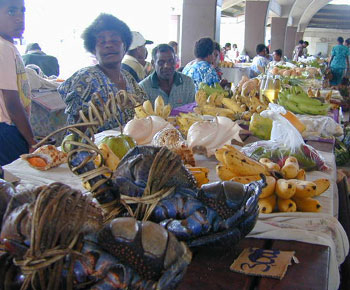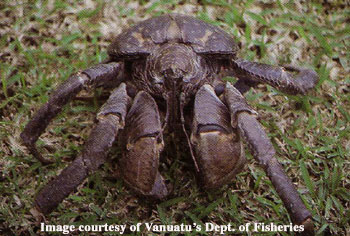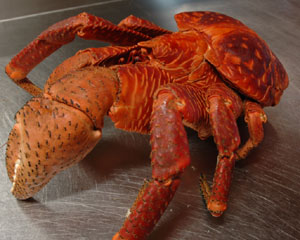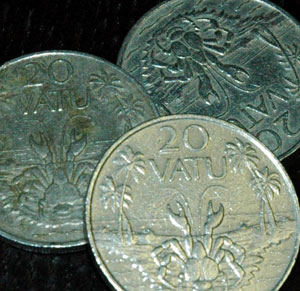Vanuatu's Disappearing Coconut Crabs
The Vanuatu Series > FM 107 > Vanuatu Beef > Coconut Crabs > Ambrym > Casino
Ever stumble out of bed to find yourself in a strange, strange land? For the Captain, the stumbling happens no matter the location, and in truth jail cells tend to become increasingly less mysterious after the fourth visit.
 But this week he's got a belly full of grog and coconut crabs on the agenda as he tours the island nation of Vanuatu in the first of three reports from the South Pacific.
But this week he's got a belly full of grog and coconut crabs on the agenda as he tours the island nation of Vanuatu in the first of three reports from the South Pacific.
The covered central market in Port Vila is the obvious choice for picking up a few coconuts or a bundle of bananas or any other foodstuff where freshness is a priority in the capital city of the Pacific island nation of Vanuatu.
But in recent years there has been a disappearance of one particular crab from the market's tables. Looking like a blue alien creature bound tightly in twine, the coconut crab was once as common as the grilled fish being fanned by ladies in flower dresses.
The culprit: a dish of curry sauce, a couple spoonfuls of coconut milk, and a few slices of toast.
"It is a delicacy," says Jason Raubani, a representative of the management division of Vanuatu's Fisheries Department. "We have a good tourism industry here, and coconut crabs are one of the big attractions that brings people to spend money in Vanuatu."
As a result of a rapid decline in numbers of the crustacean - many of which found their way onto dinner plates in restaurants in Port Vila - the Fisheries Department implemented a partial ban on the collection of the world's largest terrestrial crab. It is a move that the department hopes will rejuvenate a resource that has become a symbol of the nation.
The collection of the coconut crab, which can weigh nearly 9 pounds and live 60 years, is prohibited for the three years through 2007 in Sanma Province, the location of Vanuatu's second largest city of Luganville.
This came about following a recommendation included in a report issued in May 2003 by the Australian Centre for International Agricultural Research that summarized a survey of crab stocks.
 The report was a followup to a survey from 10 years prior that gave rise to annual quotas and closed collection periods for the provinces of Sanma and Torba.
The report was a followup to a survey from 10 years prior that gave rise to annual quotas and closed collection periods for the provinces of Sanma and Torba.
"In Torba Province," Raubani says of the region which includes Vanuatu's northernmost Banks and Torres islands, "collecting crabs is one of the few ways in which people can get an income. Management and sustainability of this resource is vital."
The crabs spend most of the daylight hours within the protection provided by hollow areas in tree stumps or rock crevices. At night, the omnivores, whose two powerful front claws can literally cut into a coconut, scavenge for fruit or small animals.
"The local landowners are the collectors," says Raubani. "They sell them to wholesalers who in turn ship them to the hotels and restaurants of either Luganville or Port Vila."
Collectors bait paths with chunks of fruit. Armed with flashlights, they can easily gather the crabs emerging from their holes to seek food.
Allan Palmer, a lifelong resident of Vanuatu and manager of a gaming club, recalls seeing crabs in great numbers on Port Vila's island of Efate. "In the evenings," he says, "I would see them dashing across the road as I drove up into the hills."
Today there are most likely none.
 He noticed that the crab population started to dwindle on Efate just after Vanuatu's independence in 1980 from joint French and British rule. He remembers that being the time when the population started to really increase and people started adapting to modern civilization. "Collecting the crabs in large quantities just became easier with cars," he says.
He noticed that the crab population started to dwindle on Efate just after Vanuatu's independence in 1980 from joint French and British rule. He remembers that being the time when the population started to really increase and people started adapting to modern civilization. "Collecting the crabs in large quantities just became easier with cars," he says.
Given that the condition of the stocks had actually gotten worse in Sanma in the intervening years between reports, the 2003 report recommended the outright ban that is now in place. (A limit of 2,000 crabs with a closed season from October to April for Sanma had been set following the previous report.)
The 2003 report cites poaching, for which there is a fine of up to 100,000 vatu (roughly 923 U.S. dollars), as a prime factor in the poor performance. The report stated, "the general effectiveness of the management in this region has been low."
Since the results of the measures for Torba - which included a restricted season between August and November and an annual quota of 5,000 crabs - in the 2003 report were said to be "moderate to high," further recommendations were not made.
Though its shell color can vary from red to blue, the coconut crab can be found scaling trees and picking at dead rats in the island regions north of Australia and between the southern Pacific and Indian oceans.
Taking steps to ensure their preservation has been an issue in Vanuatu since the early 1980s. A fisheries act aimed at protecting females of egg-bearing age prohibits the collection of any crab whose carapace (roughly the length of its torso) is less than 9 cm.
Legal crabs in Vanuatu can still be obtained from places like Penama Province, where the famous land divers test their manhood by leaping with a single vine tied to their ankle from wood structures built high up into the air.
 At the restaurant at the Sunset Bungalows resort in Port Vila, a crab meal cooked up with curry sauce and coconut milk is still available for 3,600 vatu (or 33 dollars).
At the restaurant at the Sunset Bungalows resort in Port Vila, a crab meal cooked up with curry sauce and coconut milk is still available for 3,600 vatu (or 33 dollars).
In the local Bislama tongue, Palmer says, the phrase "big bol" - a reference to the bowl-like shape of the crab's abdomen - is often used in markets when inquiring about the size of available crabs.
After the crab has been sufficiently "bled" (whereby it is cracked in the head with a knife with its internal fluids being allowed to drain out to remove any bitterness) it is boiled to a bright red. The chef will then mix the curry sauce and coconut milk inside the crab's abdomen to form a pate that can be spread over toast.
French people, however, says waitress Mary Florina Tiano at the Sunset Bungalows, "just want it boiled and served with lettuce, vegetables, and mayonnaise on the side."
With the Vanuatu government being preoccupied with accepting international aid and providing tax-free banking havens, reports from international aid agencies have shown that health and eduction in the outer islands have not improved from their low levels since independence.
Raubani hopes the coconut crab, shown raising its massive claws on the nation's 20-vatu coin, will not be similarly neglected and remain alongside the nation's live volcanoes and lush jungles as a point of great pride.
"After 2007," he says, "there will probably be another survey to see if there is a need to extend that ban. But we hope that in the past three years the number of crabs has been rejuvenated. It will depend on whether the management in Sanma has been implemented effectively."
The Vanuatu Series > FM 107 > Vanuatu Beef > Coconut Crabs > Ambrym > Casino

